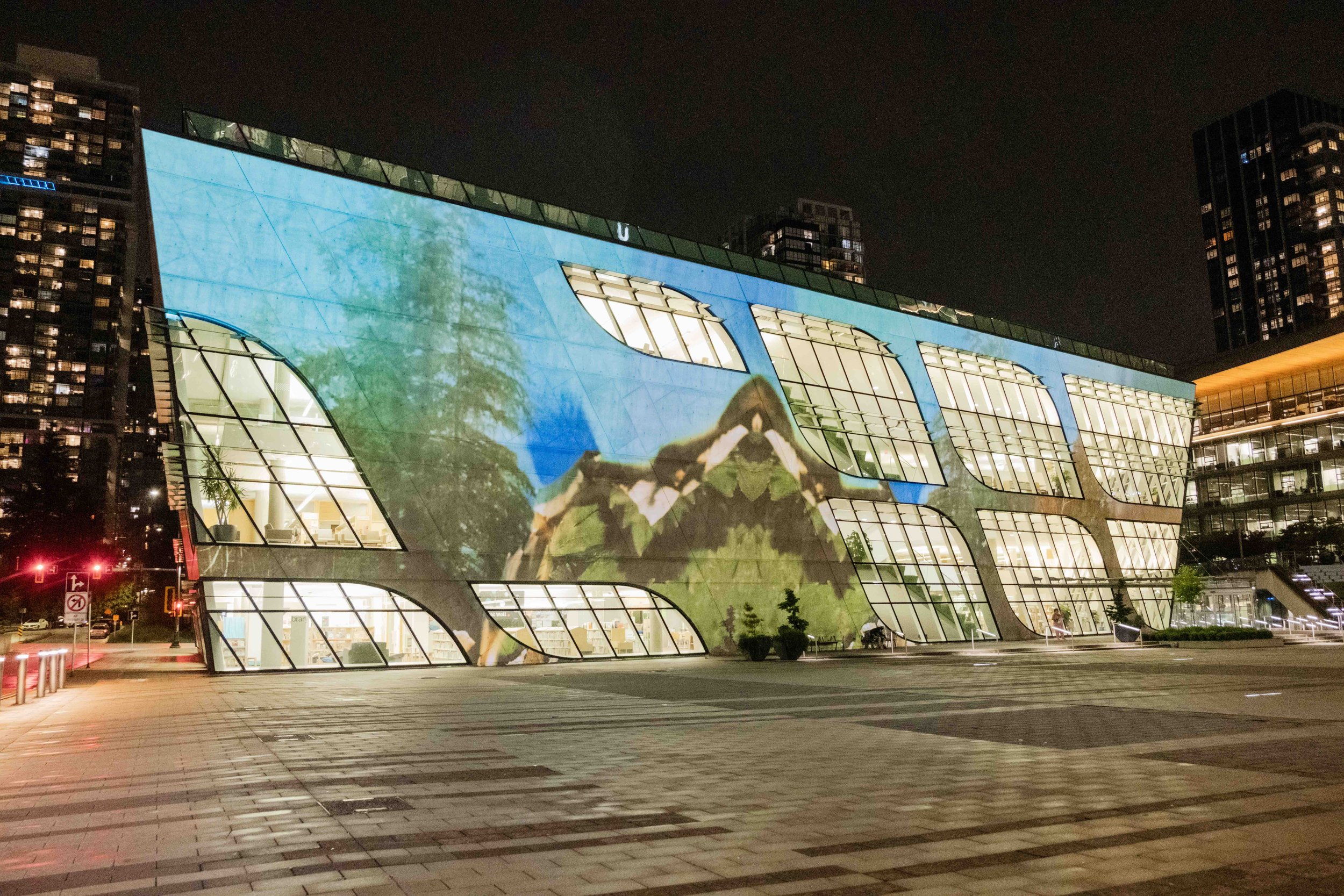In Surrey Art Gallery's Invisible Fish, ideas of waterways, connection, and environment flow together
Showcasing works by emerging Salish artists and others, exhibit draws inspiration from nearby Bear Creek Park
Nash’mene’ta’naht Atheana Picha’s Two Sturgeons, 2022, block print. Photo courtesy of the artist
Susan Point’s The River Woven by Time, 2002, serigraph print. Photo by SITE Photography
Surrey Art Gallery presents Invisible Fish to September 3
FOR INSPIRATION for the summer show Invisible Fish, curator Alanna Edwards only had to look outside Surrey Art Gallery’s doors to Bear Creek Park.
She’s often walked its trails that wind through forests across bridges and streams where, between October and mid-November, three species of Pacific salmon come to spawn.
“I’m really lucky to see that cycle,” the Surrey Art Gallery’s education and engagement coordinator says in a phone interview with Stir. “I always try to have this daily walk where I’m thinking about where I am, being on Salish territory, thinking about the water, and that the choices that we make today have these repercussions and impacts. I’m thinking about big questions, like ‘What can I do today to ensure a future?’”
Those ideas were on Edwards’s mind when she came across a poem called “Invisible Fish” by Muscogee Nation poet Joy Harjo: “Invisible fish swim this ghost ocean now described by waves of sand, by water-worn rock. Soon the fish will learn to walk. Then humans will come ashore and paint dreams on the dying stone,” reads the piece in her Secrets from the Center of the World.
“To me that really speaks to the mundanity of life and the extraordinariness of life where we’re just one part of a long line,” Edwards says.
Those themes brought together her vision for the show that borrows its title from the poem. The result is an exhibit of works by mostly Salish artists, many of them women who are early in their careers. The collected pieces explore the familial and community connections around waterways.
One of those emerging Salish talents is Kwantlen Nation artist Nash’mene’ta’naht Atheana Picha, whose block print Two Sturgeons depicts a black-formline pair of fish intertwining like the flow of water.
“It just makes us think of the environment and how our decisions have repercussions,” Edwards says of the work. “It makes us think about the sturgeon of the Fraser River and how human-made destruction is affecting habitat loss, and how this affects animals that are so important for the Nations along the water.
“By having pieces like Athena’s in the exhibit, I want visitors to really reflect on how they come to this territory and what it means to be here, whether they’re visiting from other places in BC or whether they’re from Surrey, and thinking about the responsibility they have being here.”
Gallerygoers will also be able to see—and even touch—the hulking, two-and-a-half-metre carved wood block that Picha used to make the large-scale vertical print.
Roxanne Charles’s SḰE,ḰÁL Microphone installation. Photo by SITE Photography
Picha’s imagery pairs well with veteran Indigenous artist Susan Point’s serigraph print The River Woven by Time, also depicting sturgeons, via a flowing design that references Salish weaving patterns.
Visitors are greeted at the entrance of the exhibition space with Tacoma-based, Black, white, and Salish artist Paige Pettibon’s Water & Womb—a painting of a pregnant woman standing strong on her territory. To Edwards, the image speaks to preserving the future for “the people who will come after us”.
The curator has infused the exhibit with multisensory elements—including a fort-like installation called Threshold, by Manuel Axel Strain, that visitors are invited to enter. “With this piece there’s a diffuser element, and this diffuser will have scents like juniper, willow bark, and lavender going at select days and times at the gallery,” Edwards says of the piece by Strain, a 2-Spirit artist who hails from the lands of the xʷməθkʷəyəm (Musqueam), Simpcw, and Syilx peoples.
Elsewhere, artist Roxanne Charles’s installation ŚЌE,ЌÁL / Microphone, created with community at Semiahmoo and part of Surrey Art Gallery’s permanent collection, incorporates sound. The song that plays is a Semiahmoo war song, altered by elders in the 1900s to talk about colonial violence, Edwards explains. The visual components include an intricate piece of weaving that's an homage to that Salish art form, as well as two wooden panels: one that resembles both the waves of a voice recording and mountain peaks, the other echoing the form of a Salish moon.
And there’s even the element of taste as part of Invisible Fish: the virtual event Soba’s Corner: A Chinese-Canadian Cooking Show, with exhibiting artist Snack Witch aka Joni Cheung, takes place on August 29 from 5 p.m. to 6 p.m. “In the exhibition, there’s also a video of her cooking Chinese-Canadian recipes, and with that we have a communal candy bowl with select hard candies by Joni and other artists that people are able to take while they sit there and watch,” Edwards adds, tying that work back to the show’s wider themes of connection and family. “And these candies are a bit of a reflection of going to a Chinese-Canadian restaurant and at the end you get your bill and candies, or even thinking about families that really love to host people and the generosity of having overflowing bowls of food and candies for visitors.”
In other interactive events, as part of Invisible Fish, Deanna Miller leads the weʔ ʔayəm kws niʔct ʔiməx Plant Walk with šxwne:m Deanna Miller takes place on July 22 from 10 a.m. to 11:30 a.m. and a Plant Knowledge & Medicine Making Workshopon August 12 from 1 p.m. to 4 p.m. Find more information at www.surrey.ca/arts-culture/surrey-art-gallery.
















